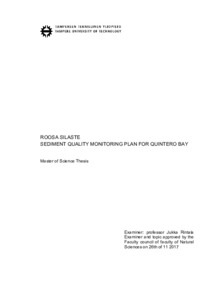Sediment quality monitoring plan for Quintero Bay
Silaste, Roosa (2017)
Silaste, Roosa
2017
Ympäristö- ja energiatekniikka
Teknis-luonnontieteellinen tiedekunta - Faculty of Natural Sciences
This publication is copyrighted. You may download, display and print it for Your own personal use. Commercial use is prohibited.
Hyväksymispäivämäärä
2017-12-07
Julkaisun pysyvä osoite on
https://urn.fi/URN:NBN:fi:tty-201711272268
https://urn.fi/URN:NBN:fi:tty-201711272268
Tiivistelmä
Marine sediment contamination by persistent pollutants such as heavy metals poses one of the worst problems to marine ecosystems. Currently in Chile, there are no mandatory environmental quality standards for coastal sediments. This is partly due to lack of environmental legislation as well as insufficient toxicity data and appropriate sediment monitoring techniques.
The Quintero bay, located in Valparaiso province in the coastal area of Central Chile, was used for this study. The industrial complex of Quintero Bay is considered one of the largest in Chile and has approximately 14 companies in current operation, including cement plants, copper smelters, copper concentrators and four coal fueled thermoelectric plants. The aim of this research was to examine the current status of heavy metal pollution of the sediments in Quintero Bay in order to forward the development of any future sediment environmental quality standards (EQS) or monitoring programs in Chile. The study focuses on the heavy metal concentrations in the marine sediments. Several studies of contaminated sediments in Quintero Bay have been carried out and the results obtained from four different sources have been analyzed in this study.
Heavy metal concentrations were determined and compared to existing sediment quality guidelines. Almost all of the results of the previous studies indicate that all metal concentrations, except arsenic and copper, fell within the lower end of the sediment quality guideline range. This may signify that those metals from the sediments pose little to no potential threat to the marine organisms. Based on the Canadian SQGs, arsenic and copper will most likely cause adverse biological effects. The Quintero Bay could be categorized as unpolluted to slightly polluted marine environment, so it is important to monitor and evaluate the possible impacts of heavy metals in the sediments. Since the legislation is not available in Chile, it is advisable to evaluate the results with some of the existing EQS, and use the data for establishing local sediment quality guidelines in the future.
The Quintero bay, located in Valparaiso province in the coastal area of Central Chile, was used for this study. The industrial complex of Quintero Bay is considered one of the largest in Chile and has approximately 14 companies in current operation, including cement plants, copper smelters, copper concentrators and four coal fueled thermoelectric plants. The aim of this research was to examine the current status of heavy metal pollution of the sediments in Quintero Bay in order to forward the development of any future sediment environmental quality standards (EQS) or monitoring programs in Chile. The study focuses on the heavy metal concentrations in the marine sediments. Several studies of contaminated sediments in Quintero Bay have been carried out and the results obtained from four different sources have been analyzed in this study.
Heavy metal concentrations were determined and compared to existing sediment quality guidelines. Almost all of the results of the previous studies indicate that all metal concentrations, except arsenic and copper, fell within the lower end of the sediment quality guideline range. This may signify that those metals from the sediments pose little to no potential threat to the marine organisms. Based on the Canadian SQGs, arsenic and copper will most likely cause adverse biological effects. The Quintero Bay could be categorized as unpolluted to slightly polluted marine environment, so it is important to monitor and evaluate the possible impacts of heavy metals in the sediments. Since the legislation is not available in Chile, it is advisable to evaluate the results with some of the existing EQS, and use the data for establishing local sediment quality guidelines in the future.
